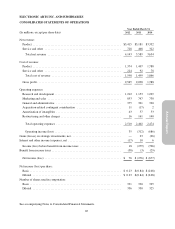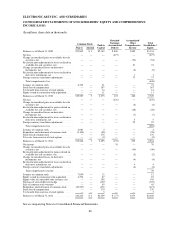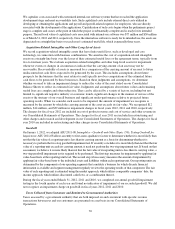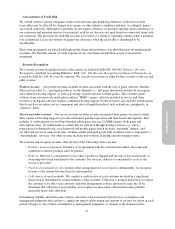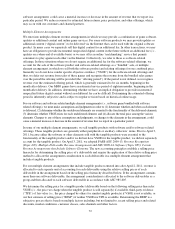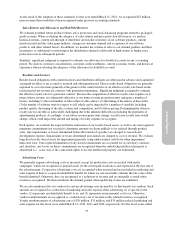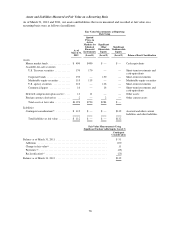Electronic Arts 2012 Annual Report Download - page 157
Download and view the complete annual report
Please find page 157 of the 2012 Electronic Arts annual report below. You can navigate through the pages in the report by either clicking on the pages listed below, or by using the keyword search tool below to find specific information within the annual report.
Annual Report
As the result of the adoption of these standards, for the year ended March 31, 2012, we recognized $23 million
more revenue than would have been recognized under previous accounting standards.
Sales Returns and Allowances and Bad Debt Reserves
We estimate potential future product returns, price protection and stock-balancing programs related to packaged-
goods revenue. When evaluating the adequacy of sales returns and price protection allowances, we analyze
historical returns, current sell-through of distributor and retailer inventory of our software products, current
trends in retail and the video game industry, changes in customer demand and acceptance of our software
products, and other related factors. In addition, we monitor the volume of sales to our channel partners and their
inventories, as substantial overstocking in the distribution channel could result in high returns or higher price
protection costs in subsequent periods.
Similarly, significant judgment is required to estimate our allowance for doubtful accounts in any accounting
period. We analyze customer concentrations, customer credit-worthiness, current economic trends, and historical
experience when evaluating the adequacy of the allowance for doubtful accounts.
Royalties and Licenses
Royalty-based obligations with content licensors and distribution affiliates are either paid in advance and capitalized
as prepaid royalties or are accrued as incurred and subsequently paid. These royalty-based obligations are generally
expensed to cost of revenue generally at the greater of the contractual rate or an effective royalty rate based on the
total projected net revenue for contracts with guaranteed minimums,. Significant judgment is required to estimate
the effective royalty rate for a particular contract. Because the computation of effective royalty rates requires us to
project future revenue, it is inherently subjective as our future revenue projections must anticipate a number of
factors, including (1) the total number of titles subject to the contract, (2) the timing of the release of these titles,
(3) the number of software units we expect to sell, which can be impacted by a number of variables, including
product quality, the timing of the title’s release and competition, and (4) future pricing. Determining the effective
royalty rate for our titles is particularly challenging due to the inherent difficulty in predicting the popularity of
entertainment products. Accordingly, if our future revenue projections change, our effective royalty rates would
change, which could impact the amount and timing of royalty expense we recognize.
Each quarter, we evaluate the expected future realization of our royalty-based assets, as well as any unrecognized
minimum commitments not yet paid to determine amounts we deem unlikely to be realized through product
sales. Any impairments or losses determined before the launch of a product are charged to research and
development expense. Impairments or losses determined post-launch are charged to cost of revenue. We evaluate
long-lived royalty-based assets for impairment generally using undiscounted cash flows when impairment
indicators exist. Unrecognized minimum royalty-based commitments are accounted for as executory contracts
and, therefore, any losses on these commitments are recognized when the underlying intellectual property is
abandoned (i.e., cease use) or the contractual rights to use the intellectual property are terminated.
Advertising Costs
We generally expense advertising costs as incurred, except for production costs associated with media
campaigns, which are recognized as prepaid assets (to the extent paid in advance) and expensed at the first run of
the advertisement. Cooperative advertising costs are recognized when incurred and are included in marketing and
sales expense if there is a separate identifiable benefit for which we can reasonably estimate the fair value of the
benefit identified. Otherwise, they are recognized as a reduction of revenue and are generally accrued when
revenue is recognized. We then reimburse the channel partner when qualifying claims are submitted.
We are also reimbursed by our vendors for certain advertising costs incurred by us that benefit our vendors. Such
amounts are recognized as a reduction of marketing and sales expense if the advertising (1) is specific to the
vendor, (2) represents an identifiable benefit to us, and (3) represents an incremental cost to us. Otherwise,
vendor reimbursements are recognized as a reduction of cost of revenue as the related revenue is recognized.
Vendor reimbursements of advertising costs of $39 million, $31 million, and $39 million reduced marketing and
sales expense for the fiscal years ended March 31, 2012, 2011 and 2010, respectively. For the fiscal years ended
73




